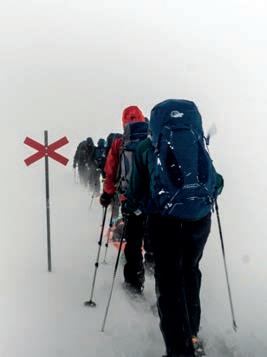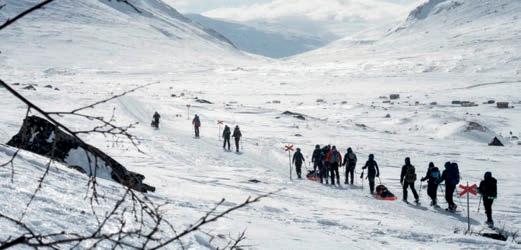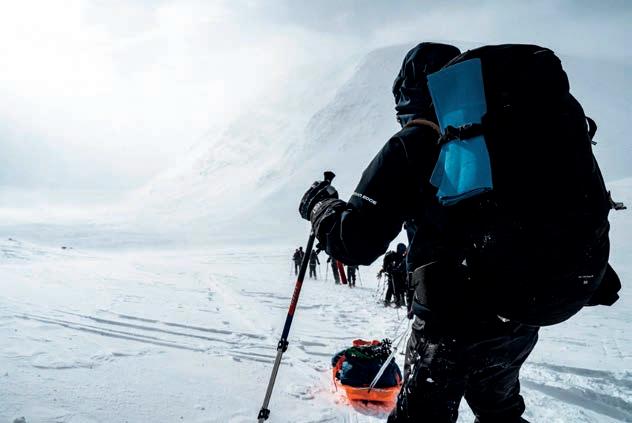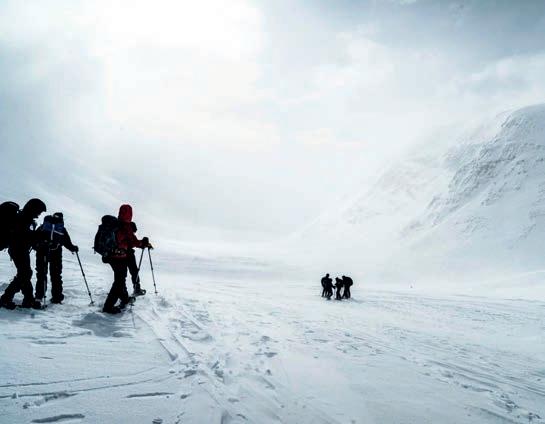
4 minute read
Expedition Limitless 2023
In the March/April edition, the Expedition Limitless Team was featured as they prepared for their once in a lifetime Arctic Expedition in aid of Isle Listen. The Expedition team set out with two goals in mind, to raise awareness of mental health and prove the innate resilience that resides in all of us when faced with adversity but also to raise £50,000 to support Isle Listen and the important work they do in our schools and community.
Words by: Martin Malone, Expedition Team Member Photography by: Simon Powner, SP Media Productions
Advertisement
As we set off on our long journey to the Arctic, there were signs of the spring bloom on the Isle of Man but in the Arctic, we would face temperatures as low as -25 degrees.
As we stepped off the overnight train in Abisko, 200km inside the Arctic circle, we were tired but we had time in the Abisko mountain station to rest. We also had time to check our kit and our two pulks (small sledges), which contained emergency shelters and half the food that would sustain us for 7 days as we trekked 110km, unsupported, along the Kungsladen route in Arctic Sweden.
After months of meticulous planning and preparation the day had finally come. As we ate our last breakfast in civilisation, there was an air of excitement but also nervousness in anticipation of what was to come. It was -12 degrees Celsius as we set off on day 1 from Abisko to Abiskojaure covering 15km. The sun was shining and it was a good reintroduction to walking in snowshoes. As we wandered through the valley in the birch forests, the scenery was beautiful. We finished day one in good spirits as we reached the first of our Arctic huts. The Arctic huts along the Kungsleden route are managed by the STF (Svenska Turistforeningen) for the safety and benefit of all explorers. They are basic with no electricity, but they have wooden bunk beds, a log burner to keep us warm and gas bottles to boil water. The first job at each hut is to chop firewood and collect drinking water from under the ice.
At the end of day 1 some of the team had blisters forming, which can become a big problem if not managed. If a team member is unable to carry on due to blisters or an injury, they have to be airlifted or rescued by a long-distance skidoo. This is something we all wanted to avoid.
Day 2, the longest day, covered 21km from Abiskojaure to Alesjaure. The temperature had dropped to -25 overnight and it was bitterly cold as we started to climb into the mountains. As we reached the plateau after 300m of ascent, the views were breathtaking. 21km had, however, taken its toll with more blisters and injuries starting to appear that required attention. Part of our daily routine was to assess the weather each night using our satellite phone. Unfortunately, we had some bad weather coming in which meant an early start on day 3 to try and stay ahead of it.
Day 3 from Alesjaure to Tjakta was extremely challenging. We battled through the 12km facing strong cross winds, driving snow and poor visibility. When we made it to Tjakta, we were told that we may not be able to proceed on day 4 and would have to stay 2 nights to let the weather clear. This meant we would have to do two legs and 24km on day 5 to catch up. The blister and injury situation had worsened but thankfully we had a doctor, physio and sports masseur on the team to help manage these issues.
When we woke on day 4, the weather had improved with the wind and snow now in our backs. Following a risk assessment, we decided to go the 12km to our next stop at Salka, taking us over the highest point of the route. It was another gruelling day with, wind, snow and technical descents. Our hut was a very welcome sight that night. After the chores were done and everyone had eaten, the focus was now on treating the blisters and injuries.
When we woke on Day 5, the sun was shining once again for our 12km trek to Singi. The views all day were astonishing and that night, with clear skies, the Northern Lights gave us the most wonderful display. It’s difficult to put into words how incredibly beautiful the Arctic is and day 5 blessed us with unforgettable memories.
Day 6 was very cold as we left Singi for our 14km trek to the Kebnekaise Mountain Station. We were looking forward to reaching Kebnekaise as it has a shop and somewhere to eat cooked food, a nice change from dried food. As we trekked under beautiful mountains and glaciers all day, the team was in high spirits, but worsening injuries were a concern. Two team members struggled to finish in Kebnekaise, so a decision had to be made that night if they could continue. Thankfully after extensive treatment both bravely decided to carry on.
Day 7 had finally arrived. An early ‘alpine start’ was required to cover the final 19km and catch our bus from Nikkaluokta to Kiruna where we would stay over-night before our long train journey back to Stockholm. It was -20 as we left Kebnekaise in the dark. We were excited but a little sad that our adventure was almost over. Our injured members were cooping well, so we were all able to enjoy the beautiful scenery. We even saw Moose and Reindeer in the valley.

During that final km to the finish, there was an intense feeling of accomplishment and even more special that everyone finished together. Through team work we had proven how resilient we all are and that adversity brings out the best in us. We had tears, laughter, pain and every emotion you could think of, but we did it, we conquered the mighty Kungsleden.




At the time of writing, we have raised a staggering £61k for Isle Listen with donations still coming in.








